It was just this past February that we told you there was pretty good info that Porsche was looking to build an all-electric sport sedan that could compete with Tesla. As the time the concept was nicknamed the “Type 717”. Today, we got confirmation from Porsche that not only are they exploring the all electric market, they’ve built their first concept: Mission E. If you thought the change from normally aspirated to turbo charged engines for the 911 series was a sea change, wait until you read the details on this all-electric Porsche. Let’s take a closer look.
Porsche’s Mission E Drive System
Recently, Porsche announced they would continue with the 919 Hybrid LMP1 program until 2018. A big part of their decision was due to the ability to have technology that is created and tested on the track roll down into the production line and future models. The Mission E is a great example of that philosophy. While its drive system is entirely new, the two (2) permanently-excited synchronous motors (PSM) are very similar to those used on the 919 Hybrid. They provide both acceleration and energy recovery during braking. These 2 PSMs, on the Mission E, combine to produce over 600 hp and the ability to launch the Mission E to a speed of 62 mph in less than 3.5 seconds. Even better, they are capable of pushing the Mission E to nearly 125 mph in under 12 seconds. I want to try one of these on a drag strip. Imagine the G’s as you launch off the line.
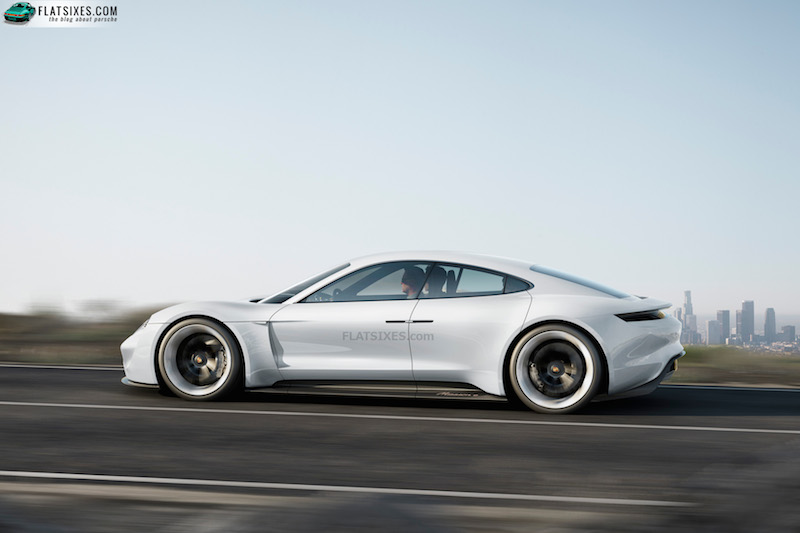
Porsche says that unlike many of the other electric drive systems available today, the PSMs can develop their full power even after multiple accelerations at short intervals. In other words, it’s okay to pass! The two drives are coupled to a “need-based” all-wheel drive system that uses Porsche Torque Vectoring to distribute torque to the individual wheels. Combine these with standard all-wheel steering and the Mission E can lap the North Loop of the Nürburgring in under 8 minutes!
How Far Can The Mission E Drive on one Charge?
The Mission E utilizes an innovative 800-volt technology that doubles the voltage found on today’s 400 volt electric vehicles. By doing so, Porsche achieves shorter charging times and lower weight. This means that the Mission E can travel 500 kilometers on one battery charge and can then be charged with enough power for 400 kilometers more in less than 15 minutes. This essentially gives you a 900 km range using a stop only slightly longer in time than it would take to fill a conventional gas tank.
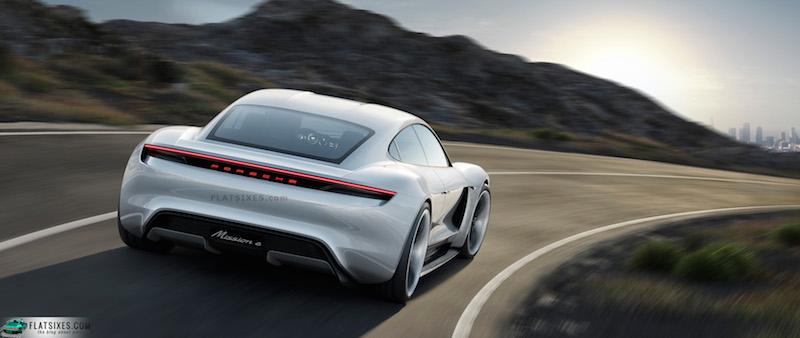
Of even more interest, if you’re at home, the car Mission E can be charged without cord. The new system utilizes inductive charging technology. Simply park your Mission E over a coil embedded into the floor of the garage (we envision this will come to market as a large mat) and the energy can be transferred with cables. Remarkable!
More About The Battery Design
When we first discussed an all electric Porsche we thought the batteries would be placed in a hump assembly using the center tunnel for the largest concentration of them. Porsche says the Mission E’s battery is mounted in the car’s underbody and runs the whole length of it between the front and rear axles. As a result, weight is distributed evenly and the center of gravity is extremely low. Combined with a body made from an aluminum, steel and carbon fiber reinforced polymer, with wide tires (21″ up front, 22″ in the rear) on wheels made of carbon and you get a great sports car feel.
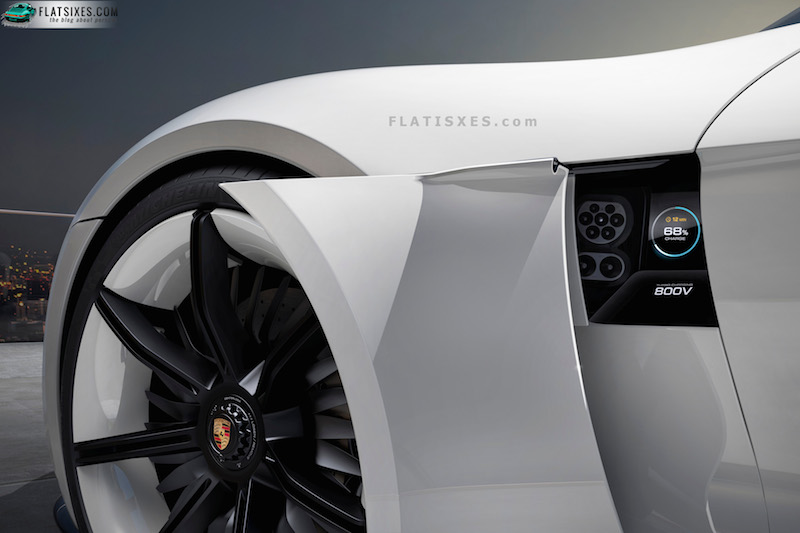
The body itself is just over 4′ tall at 130 centimeters. Aerodynamics are integrated into the body with distinctive air inlets and outlets on the front, sides and rear of the Mission E. Not only do these work to give the Mission E a lower drag coefficient, the integrated air guides improve air-flow around the wheels, and air outlets on the sides reduce overpressure in the wheel wells, reducing lift.
Some Of The Cool Technology On Porsche’s Mission E
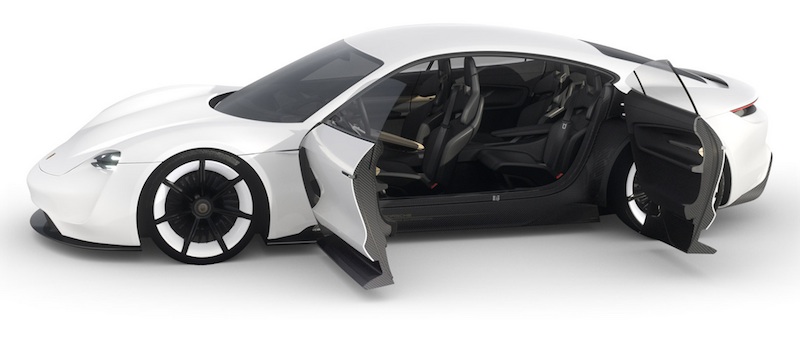
Besides the groundbreaking motors, range and charging capability, the Mission E is still all Porsche. Because it seats four in individual bucket seats you might initially think Panamera. However, on closer inspection, its lines are distinctively 911 focused (other than the missing B pillar). The rear “suicide” doors allow for easy entry for rear passengers while keeping the side profile clearly Porsche. If the Mission E’s side profile looks especially clean, its due to the lack of door mirrors. Instead of these, cameras are mounted on the sides with information transmitted to the lower corners of the front windshield.
Display and Control Concepts
While the instrument cluster displays the five round gauges we’ve come to expect in a Porsche, they are displayed virtually using OLED technology. The round instruments are organized according to the driver-relevant themes of Connected Car, Performance, Drive, Energy and Sport Chrono. The controls are just as innovative. An eye-tracking system detects, via camera, which instrument the driver is viewing. The driver can then activate the menu of the instrument in focus by pushing a button on the steering wheel and navigate to it – which also involves an interplay of eye-tracking and manual activation.

Amazingly, this display follows the seat position and body attitude of the driver in what is known as a parallax effect. If the driver sits lower, higher or leans to one side, the 3D display of the round instruments reacts and moves with the driver. This eliminates situations in which the steering wheel blocks the driver’s view of certain key information
Holographic Display
Last, but not least, comes the holographic display. The dashboard of the Mission E is essentially divided into two (2) three-dimensional layers. The upper layer is the driver’s display and between it and the bottom layer is the holographic display. Either the driver – or passenger –can use these apps to touch-free control primary functions such as media, navigation, climate control, contacts and vehicle. The desired symbol is activated by gestures that are detected by sensors. A grasping gesture means select, while pulling means control. If all that moving around gets to be too much, the driver or the passenger can use a touch display on the center console to control secondary functions such as detailed information menus.
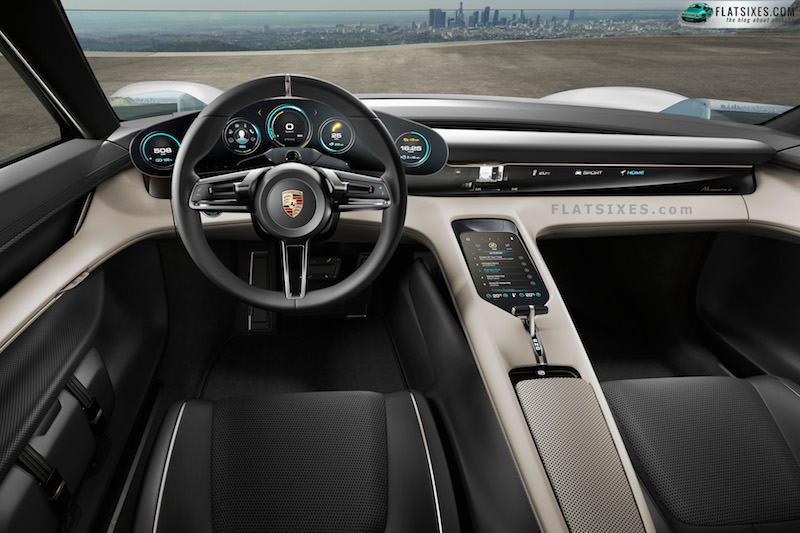
Oh Yeah. The Mission E Is “Connected?
Taking Porsche Car Connect (PCC) to the next level, the Mission E can be configured using a Tablet and the PCC app. Everything from navigation to updates for the chassis, engine and infotainment system can be made. Lost your key? Not a problem. With a direct connection to your local Porsche Center, using the Porsche Connect Portal, you can send a digital key to either yourself, or to authorized family and friends. You even have the ability to electronically set the time and locations a key can be used. Talk about enforcing a curfew!
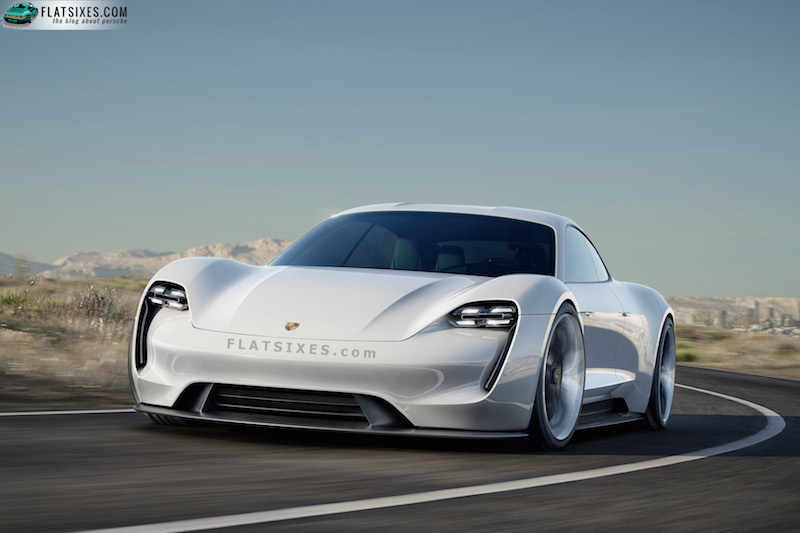
Shut Up And Take My Money!
For now the Mission E is just a concept car, but then again, so was the 918. With CAFE regulations requiring stricter and stricter guidelines between now and 2018, an all electric Porsche isn’t really a question of if, but rather a question of when. If Porsche can deliver anything even remotely close to the look and specs of this concept I think it might be time to start shorting Tesla’s stock.
For even more details, and an amazingly immersive experience, check out the Porsche Concept Study Mission E microsite.
